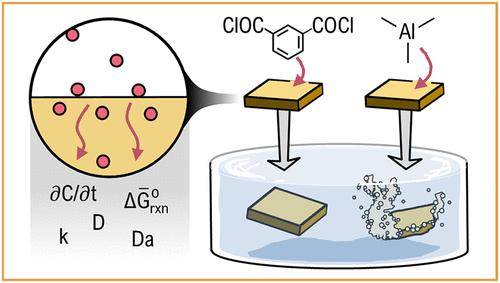溶解弹性聚合物的有机气相渗透和分子层沉积动力学和热力学研究
IF 7
2区 材料科学
Q2 CHEMISTRY, PHYSICAL
引用次数: 0
摘要
气相化学合成技术,如原子层沉积(ALD)和气相渗透(VPI),可以通过沉积或加入无机组分来实现聚合物材料的分子水平剪裁。然而,好处往往伴随着机械稳定性和有机-无机键的受损,这些键容易通过水解降解。为了解决这些限制,我们研究了全有机VPI和分子层沉积(MLD)化学作为增强聚合物性能的策略。我们研究了三种芳香族阶梯生长聚合反应的反应扩散动力学和热力学行为:聚酰胺(异苯甲酰氯+间苯二胺,MPD),聚脲(1,4-苯基二异氰酸酯+ MPD)和聚酰亚胺(对苯二甲酸+ MPD)。它们的材料生长是通过MLD在不吸收的硅和氧化锆表面发生的。有机VPI存在于大部分亲核性丰富的聚乙烯醇(PVA)中,但不通过物理包裹在非反应性聚苯乙烯和聚甲基丙烯酸甲酯中。使用反应-扩散模型,我们量化了PVA中扩散受限聚酰胺和反应受限聚脲的成核行为,确定了关键参数:扩散率、反应速率和Damköhler数。与无机氧化铝处理不同,有机改性提高了PVA的耐溶解性,即使在恶劣的pH 13溶液中也能保持聚合物的完整性和抗水解。本研究证明了全有机材料沉积在合成新型聚合物方面的潜力,这些聚合物具有更好的耐久性和溶剂弹性。本文章由计算机程序翻译,如有差异,请以英文原文为准。

Elucidating the Kinetics and Thermodynamics of Organic Vapor Phase Infiltration and Molecular Layer Deposition for Dissolution Resilient Polymers
Vapor phase chemical synthesis techniques, such as atomic layer deposition (ALD) and vapor phase infiltration (VPI), enable molecular-level tailoring of polymeric materials through deposition or incorporation of inorganic components. However, benefits are often paired with compromised mechanical stability and organic–inorganic bonds that are prone to degradation via hydrolysis. To address these limitations, we investigate all-organic VPI and molecular layer deposition (MLD) chemistries as a strategy for enhancing polymer properties. We examine the reaction-diffusion kinetics and thermodynamic behavior of three aromatic step-growth polymerization reactions: polyamide (isophthaloyl chloride + m-phenylenediamine, MPD), polyurea (1,4-phenylene diisocyanate + MPD), and polyimine (terephthalaldehyde + MPD). Their material growth occurs via MLD at the surfaces of nonabsorbing silicon and zirconia. Organic VPI occurs within the bulk of nucleophile-rich polyvinyl alcohol (PVA), but not through physical entrapment in unreactive polystyrene and poly(methyl methacrylate). Using a reaction-diffusion model, we quantify diffusion-limited polyamide and reaction-limited polyurea nucleation behavior in PVA, identifying key parameters: diffusivity, reaction rate, and Damköhler number. Unlike inorganic alumina treatment, organic modification enhances dissolution-resistance in PVA, preserving polymer integrity and resisting hydrolysis even in harsh pH 13 solutions. This study demonstrates the potential of all-organic material deposition for synthesizing novel polymers with improved durability and solvent resilience.
求助全文
通过发布文献求助,成功后即可免费获取论文全文。
去求助
来源期刊

Chemistry of Materials
工程技术-材料科学:综合
CiteScore
14.10
自引率
5.80%
发文量
929
审稿时长
1.5 months
期刊介绍:
The journal Chemistry of Materials focuses on publishing original research at the intersection of materials science and chemistry. The studies published in the journal involve chemistry as a prominent component and explore topics such as the design, synthesis, characterization, processing, understanding, and application of functional or potentially functional materials. The journal covers various areas of interest, including inorganic and organic solid-state chemistry, nanomaterials, biomaterials, thin films and polymers, and composite/hybrid materials. The journal particularly seeks papers that highlight the creation or development of innovative materials with novel optical, electrical, magnetic, catalytic, or mechanical properties. It is essential that manuscripts on these topics have a primary focus on the chemistry of materials and represent a significant advancement compared to prior research. Before external reviews are sought, submitted manuscripts undergo a review process by a minimum of two editors to ensure their appropriateness for the journal and the presence of sufficient evidence of a significant advance that will be of broad interest to the materials chemistry community.
 求助内容:
求助内容: 应助结果提醒方式:
应助结果提醒方式:


